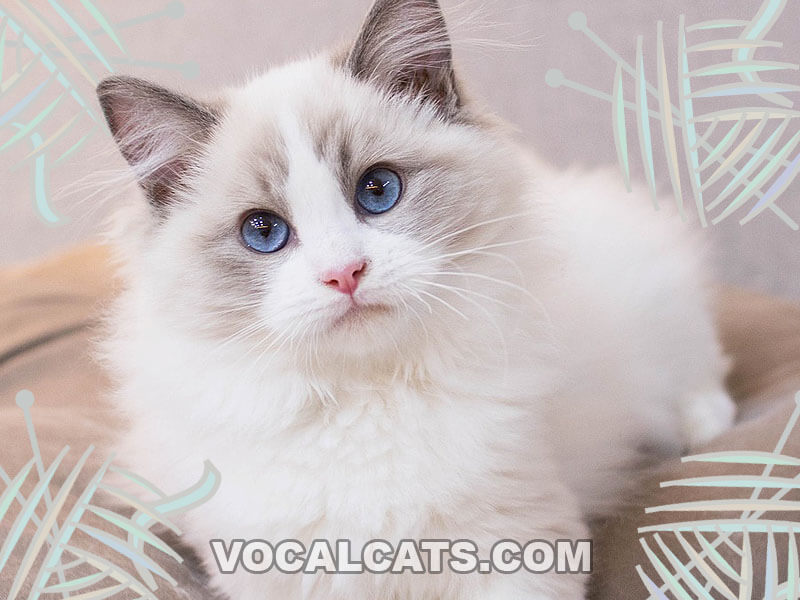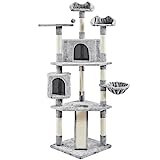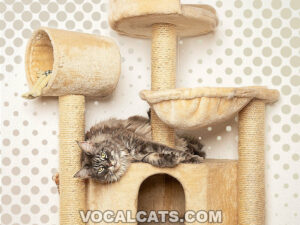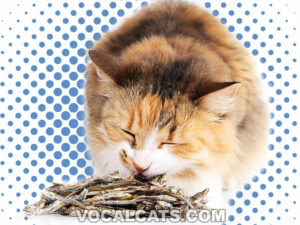If you’re looking for a fluffy friend that is affectionate, calm, and has a docile nature, look no further than the Ragdoll cat breed. Ragdolls are large furballs that love their families and have a puppy-like reputation. They come in various different colors. One of the six recognized point colors of the Ragdoll is Lilac.
The Lilac color is not purple but rather a shade of light gray with pinkish tones. Their body coat is completely white just like a White Ragdoll Cat but presents with colorpoints that are the hallmark of the Ragdoll breed.
In this comprehensive guide, we will discuss the various coat patterns found in a Lilac Ragdoll, as well as, their personality, best ways to take care of them, and in case you’re planning to adopt one, how to find a reputable breeder near you in your area.
Contents
- Lilac Ragdoll: Breed overview
- What is a Lilac Ragdoll?
- Are Lilac Ragdolls rare?
- Is Lilac a recognized Ragdoll Cat color?
- What does a Lilac Ragdoll Cat look like?
- What color are Lilac Ragdolls’ eyes?
- At what age can you tell that a Ragdoll Cat is Lilac?
- Lilac vs blue Ragdoll
- Blue point vs Lilac point Ragdoll
- Lilac Ragdoll Cat size, height, and weight
- Lilac Ragdoll colors and patterns
- Lilac Ragdoll personality and temperament
- Lilac Ragdolls training
- Ragdoll Lilac exercise requirement
- Lilac Ragdoll grooming and cleaning
- Do Lilac Ragdolls shed a lot?
- Are Lilac Ragdolls hypoallergenic?
- Essential accessories for Lilac Ragdolls
- Lilac Ragdoll food and diet
- Lilac Ragdoll health issues
- Lilac Ragdoll lifespan
- Lilac Ragdoll breeders
- Lilac Ragdoll kittens
- Lilac Ragdoll price
- Places to find Lilac Ragdoll kittens for sale
- Finding a healthy Lilac Ragdoll for sale
- Lilac Ragdoll Mix
- Lilac Ragdoll: Pros and Cons
- Is the Lilac Ragdoll right for me?
- Related Questions
Lilac Ragdoll: Breed overview
| Size | Large |
| Weight | 16 – 20 pounds |
| Height | 9 – 11 inches |
| Coat Colors | White, Light Gray, Lavender Pink |
| Child Friendliness | High |
| Feline Friendliness | High |
| Training Difficulty | Moderate |
| Grooming Upkeep | Moderate to High |
| Exercise Needs | Low – Moderate |
| Health | Moderate |
| Lifespan | 12 – 15 years |
| Kitty Costs | $2,400 upwards |
What is a Lilac Ragdoll?
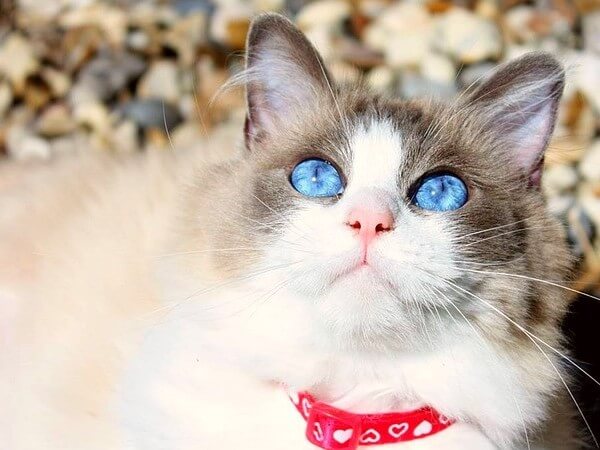
Lilac Ragdoll is a Ragdoll with a milky white fur on his body and light gray-pink points on his extremities (face, nose, ears, paws, tail).
Are Lilac Ragdolls rare?
Yes, Lilac Ragdolls are rare. That’s because to get the color lilac, the offspring must inherit the chocolate recessive gene from both parents plus a recessive dilute gene, which is statistically difficult to achieve.
READ NEXT: Chocolate Pointed Ragdoll (Complete Guide)
Is Lilac a recognized Ragdoll Cat color?
Yes, Lilac is a recognized color among Ragdolls, together with seal, cream, flame, chocolate, and blue.
CHECK OUT: Flame Point Ragdoll (Complete Guide)
What does a Lilac Ragdoll Cat look like?
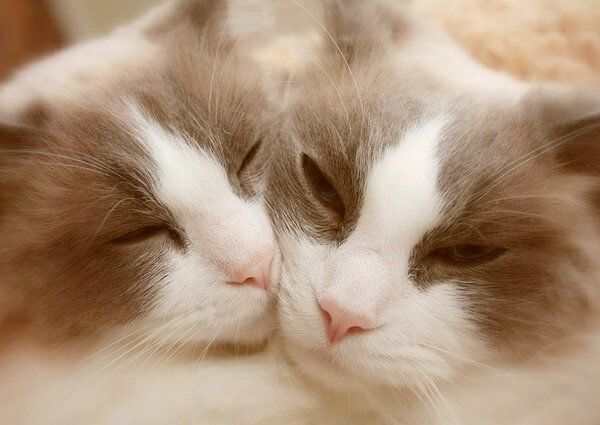
Just like all Ragdolls, a Lilac Ragdoll has a lengthy body, broad chest, short neck, and long, bushy tails. Their noses and paw pads are light pinks in color.
What color are Lilac Ragdolls’ eyes?
A Lilac Ragdoll’s eye color is blue which conforms to the standard Ragdoll breed.
READ ALSO: Blue Eyed White Ragdoll (Complete Guide)
At what age can you tell that a Ragdoll Cat is Lilac?
The color Lilac will start to appear at around 3 to 4 weeks of age, but the color will be completely evident by 8 to 12 weeks of age.
Lilac vs blue Ragdoll
The main difference between Lilac Ragdoll and Blue Ragdoll is that Lilac Ragdoll has milky white body coat while blue Ragdoll has a white to bluish-grey body coat.
Blue point vs Lilac point Ragdoll
The main difference between Blue Point Ragdoll and Lilac point Ragdoll is that Blue Point Ragdoll has dark gray colorpoints (dark grey in the extremities: face, ears, tail, paws, and nose) while Lilac point Ragdoll is very light gray with pinkish hues on his colorpoints.
Lilac Ragdoll Cat size, height, and weight
Lilac Ragdoll Cats are large in size that can weigh from 8 to 20 pounds. Male Lilac Ragdoll Cats are typically larger than female Lilac Ragdoll Cats.
Here is the size, height, and weight chart of a Lilac Ragdoll Cat:
| Height | Weight | Length | |
| Male | 9-11 inches | 15-20 pounds | 17-21inches |
| Female | 7-9 inches | 18-19 pounds | 17-19 inches |
Lilac Ragdoll colors and patterns
Lilac Ragdolls have a single coat that is thick and semi-long. Body coat color is milky white while the colorpoints on the face, nose, ears, tail, and paws are light grayish-pink.
They come in three (3) recognized Ragdoll coat patterns, namely, the colorpoint, mitted, and bi-color, as well as, in lynx and tortie variations.
Lilac point Ragdoll
Lilac colorpoint Ragdoll has milky white body coat color. The colorpoints of a Ragdoll Lilac point, which is located in the face, nose, ears, paws, and tail is very light gray in color with pinkish hues. The paw pads and the nose of Lilac point Ragdoll Cat are lavender to pink in color. Also, a Ragdoll Cat Lilac point shares the same blue eye color as all purebred Ragdolls.
The coat of a Ragdoll Lilac colorpoint is velvety soft and medium in length.
Lilac point bicolor Ragdoll will have the same colorpoints as a Lilac colourpoint Ragdoll but with an inverted and symmetrical white “V” mask mark on his face.
Lilac point Ragdoll kitten is born completely white and will fully develop his colorpoints by age two. Ragdoll kitten Lilac point typically grows at a similar rate as other domesticated cats from birth until 12 weeks of age, but Lilac point Ragdoll Cats have a growth spurt when they reach 5 months old.
Ragdolls, as well as, Lilac pointed Ragdoll will reach their full size by 2 to 4 years of age.
Lilac Bicolor Ragdoll
Lilac bicolor Ragdoll Cats have an inverted white “V” mask on the face that can extend to the edge of their eyes. Ragdoll bicolor Lilac has dark points on the top and side of the head and ears.
Lilac bi color Ragdoll points also extend toward their back up to their tail, which is referred to as the “saddle.” The coat color of the chest, chin, and underside of a Lilac bicolour Ragdoll are glacial white. A variation of the pattern is the Lilac bicolor lynx Ragdoll which has a tabby pattern on his forehead.
The paws of a bicolor Lilac Ragdoll however are white and the paw pads are pink. Nose color of a Ragdoll Lilac bicolor is also light pink.
Lilac bicolor Ragdoll kitten is born white and will develop color as he matures.
Lilac mink Ragdoll
Ragdoll Lilac mink has a light gray pinkish coat color and darker colorpoints. Lilac mink Ragdoll kitten is born with some tinge of color, unlike the traditional Ragdoll that is completely white.
Lilac mink mitted Ragdoll
Ragdoll Lilac mink mitted has a light gray body coat with darker points at the ears and tail. The dark points in a Lilac mink bicolor Ragdoll can extend on the back which is called a saddle and there is also a white inverted “V” mark on the face. The paws of the Lilac mitted mink Ragdoll is white.
Lilac mitted Ragdoll
Lilac mitted Ragdoll Cat presents with a white body coat and Lilac colorpoints in the ears, nose, and tail.
Lilac point mitted Ragdoll differs from the Lilac Colorpoint in that their paw furs are white instead of pointed.
Ragdoll Lilac point mitted may also exhibit a white blaze or white spot between the eyes. A belly stripe may also be visible in a mitted Lilac Ragdoll on her chin.
Lilac mitted Ragdoll kitten is also born white with colorpoints showing upon maturity.
Lilac lynx Ragdoll
Ragdoll Lilac lynx has a white fur on his body and light gray-pinkish colorpoints in the face, ears, paws, and tail.
The only difference between a Lilac colorpoint and a lynx Lilac Ragdoll Cat is that the forehead has the distinctive “M” shape pencil lines.
Lilac lynx point Ragdoll is sometimes referred to as Lilac tabby Ragdoll. Lilac tabby point Ragdoll also has blue eyes with the rims outlined with white liner. Lilac lynx Ragdoll kitten just like any Ragdoll will reach his full size at 2 to 4 years of age.
DON’T MISS: Ragdoll Tabby Mix (Complete Guide)
Lilac lynx mitted Ragdoll
Lilac mitted lynx Ragdoll has tabby markings on the forehead and points on the ears and tail, but the paws are mitted or white.
Lilac lynx bicolor Ragdoll
Lilac lynx bicolor Ragdoll will have a white inverted “V” shape on her face with a tabby marking on the forehead.
Solid Lilac Ragdoll
Lilac solid Ragdoll has a light grayish coat color throughout his body. Ragdoll Lilac solid can also exhibit the traditional patterns of Ragdolls, namely, colorpoint, bi-color, and mitted.
Lilac cream Ragdoll
Lilac Cream Point Ragdoll has white fur body coat color. The points are light gray-pink in a color that is interspersed with cream spottings.
A variation of the Lilac cream Ragdoll is the Lilac cream lynx point Ragdoll that has pencil “M” markings or tabby points on his forehead.
Lilac seal point Ragdoll
Lilac Seal Point Ragdoll has a light gray body coat with dark brown colorpoints on the face, nose, ears, paws, and tail.
Lilac sepia Ragdoll
Lilac Sepia Ragdoll exhibits brown to light brown coats with gray pointed markings.
Lilac tortie Ragdoll
Lilac Tortie Ragdoll presents with a white body coat that can have spots of red and cream. Their points are grayish pink which has spots of red and cream.
Blue Lilac Ragdoll
Blue Lilac Ragdoll has white body coat with cold gray points.
Blue point Lilac point Ragdoll
Blue Lilac point Ragdoll has a light gray body coat with light lavender-pink points.
Lilac Ragdoll personality and temperament
Ragdoll Cats Lilac share the same personality and temperament as all Ragdolls exhibiting a calm and docile nature. They show great affection to their family and love being in their company all the time.
In fact, Ragdolls in general have earned the reputation of being more puppy-like in their attitude than other cat breeds.
DON’T MISS: Why Does My Cat Sleep On My Head, Face and Neck? 10 Reasons Why!
Lilac Ragdolls training
Lilac Ragdolls are easy to train because of their sociable and docile personality. They respond well to positive reinforcements, like kitty treats and petting.
You can start litter training at 3 weeks of age and obedience training at 6 weeks of age.
One effective method of teaching a Ragdoll new tricks is by using a clicker in which the cat can associate a command with a specific sound.
Ragdoll Lilac exercise requirement
Lilac Ragdoll only requires short bursts of physical activity between their naps. They particularly enjoy a game of ball fetching or chasing objects on a string.
Lilac Ragdoll grooming and cleaning
Grooming a Lilac Ragdoll is not complicated, just be sure to brush her fur as often as you can to get rid of loose hair. You can either use a de-shedding tool like Furminator or a slicker brush.
Bathe him using a gentle and cat shampoo to remove dirt, fleas, and ticks.
Here is a table to guide you with the grooming needs of your Lilac Ragdoll Cat:
| Grooming Needs | Grooming Frequency |
| Hair Brushing | 3 – 4x weekly. |
| Nail Trimming | As needed. |
| Teeth Brushing | 2 -3x weekly. |
| Bathing | Once a month. |
| Eye Care | Check weekly. |
| Ear Care | Check weekly. |
Do Lilac Ragdolls shed a lot?
Lilac Ragdolls, like all Ragdoll cats, do shed. But, it’s not as severe as you might expect. They have a plush, medium-length coat that’s less likely to mat or clump compared to some other long-haired cat breeds. Think of their coat as similar to that of a Birman or Maine Coon, but without the dense undercoat.
You may be interested in: Maine Coon Ragdoll Mix (Complete Guide)
Generally, they shed more during the seasonal changes (spring and fall) just like many cats. However, the amount they shed is not as significant as, say, a Persian cat, which is known for its heavy shedding.
You may also like: Persian Ragdoll Cat (Complete Guide)
Regular grooming, about once or twice a week, can easily manage their shedding and prevent loose hairs from accumulating. This grooming frequency is less than what you might do for Persian or Himalayan cats, which often require daily grooming due to their long, thick hair.
So, while Lilac Ragdolls do shed, it’s not an overwhelming amount. Regular grooming can keep it under control. It’s not a “fur storm” situation like you might experience with some of the heavier-shedding cat breeds!
If you would like to control the amount of fur in your home during the fall and spring, here’s what you can do:
- Regular grooming
- Proper nutrition
- Keep Your feline friends hydrated
- Use a lint roller or furniture covers
- Regular cleaning and laundry
- Consider air purifiers
- Investing in a vacuum cleaner
- Regular Vet Check-ups
As mentioned above, investing in a powerful vacuum cleaner makes a huge difference. Consider getting a vacuum cleaner with a HEPA filter because it helps remove 99.9% of the fur, dust, dander, and mites in your home.
While vacuuming, the HEPA filter helps to remove any impurities from the air.
RELATED: Do Ragdoll Cats Shed? 7 Ways To Shed Less!
Are Lilac Ragdolls hypoallergenic?
No, Lilac Ragdolls are not hypoallergenic. While no cat breed is truly hypoallergenic, some breeds are known to produce fewer allergens than others. Ragdolls are not among these breeds. They produce normal levels of Fel d 1, which is the protein in cat saliva and skin secretions that triggers allergic reactions in sensitive individuals.
However, if you love cats and have mild allergies, there are steps you can take to help reduce allergens in your home. One of the most effective solutions is to invest in a high-quality air purifier with a HEPA filter (High Efficiency Particulate Air).
Air purifiers with HEPA filters can help to improve the air quality in your home by capturing and removing a wide range of allergens, including pet dander and fur. HEPA filters are able to trap 99.97% of particles that are 0.3 microns in size, making them extremely effective at reducing allergens in your home.
By using a HEPA air purifier, you can reduce the amount of cat dander in the air, which can help to alleviate allergy symptoms. This can be especially beneficial during shedding season when dander and fur levels may be higher.
In addition to using a HEPA air purifier, regular cleaning, grooming your cat, and washing your hands after petting your cat can also help to reduce allergens in your home.
Remember to change or clean the filter of the air purifier according to the manufacturer’s instructions to ensure its effectiveness.
So while Lilac Ragdolls are not hypoallergenic, with the right steps, including investing in a good air purifier with a HEPA filter, you can still enjoy the company of your lovely cats even if you have mild allergies.
Essential accessories for Lilac Ragdolls
A cat tree is a must-have for Lilac Ragdolls, known for their playful nature and large size. Select a cat tree that offers stability to support their weight and multiple levels for climbing and exploring.
Look for models with integrated scratching posts and cozy resting areas. This will not only keep your Ragdoll entertained but also provide them with a private space for relaxation, catering to their physical activity needs and instinctual behaviors.
Lilac Ragdoll food and diet
A diet high in moisture content is the best for your fuzzy friend. Therefore, you’ll want to feed your fluffy companion wet or canned food. You can serve him ½ to ¾ cups, divided into two (2) meals per day.
RECOMMENDED: Can Cats Eat Brussel Sprouts?
Lilac Ragdoll health issues
Lilac Ragdolls have the potential to develop various health issues over the course of their lives. While many Ragdolls live long, healthy lives, their genetic makeup can predispose them to certain health conditions.
Understanding your cat’s potential health risks can be crucial for their long-term health and well-being. One of the ways to gain insights about your cat’s health profile is through a cat DNA and health detection test. This test can provide detailed information about your cat’s genetic makeup, including any breed-specific predispositions to certain health issues.
Investing in a cat DNA and health detection test can be incredibly beneficial for several reasons:
- Early Detection: If you know what potential health issues your Lilac Ragdoll might be prone to, you can keep an eye out for early symptoms. Early detection often leads to more successful treatment outcomes.
- Preventive Care: If you’re aware of your cat’s predispositions, you can take preventive measures. This might include dietary adjustments, lifestyle changes, or regular screenings.
- Understanding Behavior: DNA tests can often explain certain behaviors by identifying traits that are common in certain breeds. This can help you better understand your cat’s needs and behaviors.
- Personalized Care: Knowing your cat’s genetic makeup allows you to provide personalized care tailored to their specific needs.
Remember, a cat DNA and health detection test doesn’t replace regular vet visits. It’s a tool that can complement veterinary care by providing additional insights into your cat’s health.
To learn more about the possible health issues that can affect your Lilac Ragdoll, here are three (3) health issues that Lilac Ragdoll are most susceptible to and the early symptoms:
Respiratory Problems
The flat faces and short noses of Lilac Ragdolls make them prone to breathing problems and respiratory infections.
Polycystic Kidney Disease
This is a hereditary condition that causes small cysts to form in the kidneys. Difficulty in urinating is one of the early signs.
Hairballs
Since Lilac Ragdolls have long fur, they tend to ingest some fur while grooming themselves. Unfortunately, this causes hairballs to form in the digestive system. If these are not expelled, it can cause stomach discomforts like diarrhea.
Lilac Ragdoll lifespan
Lilac Ragdolls can live for up to 15 years and even more if the right care is provided to them.
Lilac Ragdoll breeders
You can find a Lilac Ragdoll breeder near me by doing online research. After you’ve found breeders, devote some time to reading Lilac Ragdoll kittens reviews given by their past customers.
Aside from the positive reviews, it is best if you visit the Lilac Ragdoll breeders’ cattery or home in person so you can see for yourself if the kittens are raised in a clean and safe environment by the breeders.
Lilac Ragdoll kittens
One of the most important things to do before bringing home a Lilac Ragdoll kitten is to kitty proof your home and secure all escape routes. You’ll want to install window screens and make sure no wires are hanging.
Investing in a cat-proof blind is another way to kitten-proof your home because it eliminates risks associated with corded blinds. This common plaything can become a safety hazard for kittens.
Cat-proof blinds are designed with durability in mind, able to withstand the energetic antics of your new feline friend.
These blinds will enhance your home’s decor and promote a safer environment for your kitten, making them an essential investment for responsible cat owners.
You will also want to load up on the basic needs of Ragdoll kitten Lilac such as food and water bowls, grooming supplies, litter and litterbox, bed and a cat carrier.
Also, it is ideal if you already know which vet clinic to take your Ragdoll Lilac kitten for vaccinations, deworming, and in cases of unexpected emergency.
Lilac Ragdoll price
It’s not easy to find a Lilac Ragdoll, hence you can expect a Lilac Ragdoll Cat price to be on the expensive side. A Lilac Point Ragdoll price commands an average of $2,400.
Places to find Lilac Ragdoll kittens for sale
While it’s true that it can be pretty challenging to find Lilac Point Ragdoll kittens for sale, if you’re willing to wait, you can find kittens for sale by doing an online search of Lilac Ragdoll kittens for sale near me.
From there, you would get links to Ragdoll breeders near your area. To help you jumpstart your journey to finding your Lilac Ragdoll kitten, here are two (2) breeders you may want to check out for Lilac Point Ragdoll kittens for sale:
Lilac Ragdoll kittens for sale UK
Try Morant Ragdolls (morantragdolls.co.uk) located in the UK. The breeder has been breeding Lilac Ragdolls for more than 11 years now and may have the fuzzy companion you are looking for.
Lilac Ragdoll kittens for sale USA
Check out the website of Lilac City Ragdolls (lilaccityragdolls.com) located in Spokane, Washington where the kittens are sold for $1,450 plus taxes. The kittens can be viewed beginning at 8 to 10 weeks of age.
Finding a healthy Lilac Ragdoll for sale
Do you prefer adult cats and would rather look for an adult Lilac point Ragdoll for sale? Here are two (2) likely places to find them:
My Champion Heart Ragdolls (mychampionheartragdolls.com/available-kittens) located in San Diego, California have adults for sale at an average price of $2,000. If you’re not in the area, the good news is that they do international delivery.
Aberlady Ragdolls (aberladyragdolls.com) in Wahroonga, Sydney, Australia may have an adult Lilac Ragdoll for sale. You can contact the breeder directly via email for availability and pricing.
Lilac Ragdoll Mix
Some cat breeders crossbreed Lilac Ragdolls with other cat breeds. In most cases, the resulting offspring will inherit the fine behavioral qualities of Ragdolls. Here is one example:
Lilac point Siamese Ragdoll Mix
Also referred to as Ragamese, the Lilac point Siamese Ragdoll Mix is an affectionate, adventurous, and playful cat but has the tendency to be hard-headed so early training is recommended.
A Lilac Ragdoll is just like other Ragdolls but with milky white fur on her body and light grey to pink points on her extremities (face, nose, ears, paws, and tail).
Lilac is one of the rarest Ragdoll colors. Aside from Lilac, the other rare color of Ragdolls is red, also referred to as Flame Ragdolls. Flame Ragdolls are characterized by having a white coat and orange to red color points in the extremities.
CHECK OUT: Grey Ragdoll Cat (Complete Guide)
Lilac Ragdoll: Pros and Cons
Before buying a Lilac Ragdoll cat, it’s best to do your research first by learning the pros and the cons of owning one:
| Pros | Cons |
| Kind and gentle to everyone. | Moderate shedder. |
| Patient with kids. | Not hypoallergenic. |
| Friendly to other pets. | Prone to obesity. |
| Easy to train. | Expensive to buy. |
| Loves being cuddled. | Prone to hereditary diseases. |
| Does not like perching on high furniture. | Does not tolerate being left alone. |
Is the Lilac Ragdoll right for me?
A Lilac Ragdoll has a gentle soul but she is best in a family who always has someone in the house to be with her. This is because Lilac Ragdoll cannot tolerate solitude for long hours, lest she may suffer from depression.
Related Questions
A Lilac Ragdoll is just like other Ragdolls but with milky white fur on her body and light grey to pink points on her extremities (face, nose, ears, paws, and tail).
The main difference between a Lilac and Blue Ragdoll is that Lilac Ragdoll is predominately milky white with grey to pink points in the extremities (face, nose, ears, paws, and tail) while Blue Ragdoll has a white to light gray body coat color with gray to grayish-brown points in the ears, face, paws, and tail.
You will know if your Ragdoll is a Lilac by the age of 8 to 12 weeks of age. The Lilac point color (white body coat with light gray to pink points at the extremities) will start to come in at around 3 to 4 weeks of age and will come in completely at 8 to 12 weeks of age.
Lilac is one of the rarest Ragdoll colors. Aside from Lilac, the other rare color of Ragdolls is red, also referred to as Flame Ragdolls. Flame Ragdolls are characterized by having a white coat and orange to red color points in the extremities.
There is no one right answer to what the prettiest Ragdoll color is since this is a matter of personal preference as each Ragdoll owner has his or her personal favorite. However, many Ragdoll lovers prefer blue Ragdolls. This is because the blue-grayish hue coat color accentuated by colorpoints looks so amazingly classic.
Yes, bicolor Ragdolls are more expensive because it boils down to the supply and demand of this colored Ragdoll. The demand is higher for bicolor Ragdolls, especially in the USA and Australia.
Aside from Lilac being one of the accepted colors by both The International Cat Association (TICA) and Cat Fanciers’ Association (CFA), a Lilac Point Ragdoll is popular due to her attractive creamy white body coat color and the unique and subtle pinkish to lavender colorpoints in her extremities (ears, face, nose, paws, and tail).
Yes, Lilac Ragdolls can also be Lynx Ragdolls. Lilac Lynx Ragdolls are characterized by having light gray to pinkish faces with some tabby markings and light stripe patterns on their legs.
DISCLAIMER: THIS WEBSITE DOES NOT PROVIDE MEDICAL ADVICE
The information, including but not limited to, text, graphics, images and other material contained on this website are for informational purposes only. No material on this site is intended to be a substitute for professional veterinary advice, diagnosis, or treatment. Always seek the advice of your veterinarian or other qualified health care provider with any questions you may have regarding a medical condition.
Resources:
https://en.wikipedia.org/wiki/Ragdoll
https://www.avma.org/resources/pet-owners/petcare/feline-lower-urinary-tract-disease
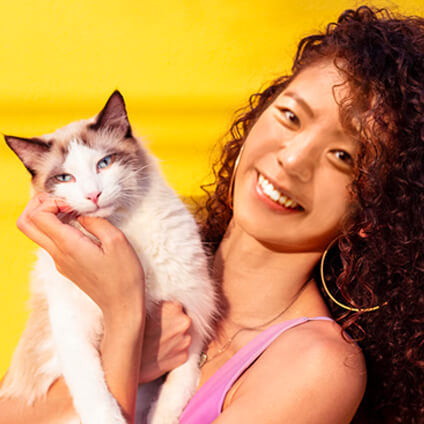
With over five years of specialized experience as an animal writer, my expertise lies in cat nutrition, health, behavior, grooming, and training. I am dedicated to delivering helpful and informative content that caters to the well-being of our feline friends. My primary goal is to empower pet owners with knowledge and ensure our feline companions thrive in health and happiness. In my free time, I love volunteering at local cat rescue centers.
